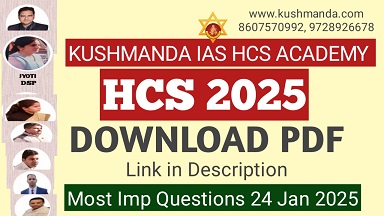HPSC HCS Prelims January 24 Most Probable 100 Questions
HPSC HCS Prelims January 24 Most Probable 100 Questions
1. Which of the following statements is true about Haryana?
A. Haryana was formed on 1st November 1966.
B. Haryana shares borders with Himachal Pradesh, Punjab, Rajasthan, and Delhi.
C. Haryana has the highest per capita income in India as per recent reports.
D. The capital of Haryana is Chandigarh, which it shares with Punjab.
Answer: D
Explanation: Haryana was formed on 1st November 1966 after being separated from Punjab. It shares borders with Punjab, Himachal Pradesh, Rajasthan, Uttar Pradesh, and Delhi but not exclusively Himachal. Chandigarh is a shared capital between Haryana and Punjab.
2. Haryana’s economy is primarily based on which sector?
A. Industrial Sector
B. Agricultural Sector
C. Tourism
D. Service Sector
Answer: B
Explanation: Haryana’s economy is primarily agrarian, contributing significantly to India’s food grain production, especially wheat and rice. The state is part of the Green Revolution regions of India.
3. In the context of the Mahabharata, which place in Haryana is considered the battlefield of Kurukshetra?
A. Panipat
B. Hisar
C. Rohtak
D. Kurukshetra
Answer: D
Explanation: Kurukshetra, located in Haryana, is historically and mythologically significant as the site of the epic battle of the Mahabharata.
4. Which of the following statements about Haryana is incorrect?
A. Haryana is the first Indian state to implement the Bhavantar Bharpai Yojana.
B. Haryana ranks among the top states in India in terms of gender ratio.
C. Haryana has a rich tradition of folk music and dance, like Ghoomar and Saang.
D. Haryana is home to the Sultanpur National Park, a famous bird sanctuary.
Answer: B
Explanation: Haryana struggles with gender inequality, reflected in its low sex ratio compared to other states. The rest of the statements are true.
5. Which city of Haryana is known as the “City of Weavers”?
A. Panipat
B. Karnal
C. Ambala
D. Gurgaon
Answer: A
Explanation: Panipat is famous for its handloom industry and is known as the “City of Weavers.” It is also known for its historical significance due to the three Battles of Panipat.
6. What is the main objective of the ‘Mhara Gaon Jagmag Gaon’ scheme launched by the Haryana Government?
A. Promoting women empowerment
B. Providing 24×7 electricity to villages
C. Promoting rural employment
D. Boosting agricultural productivity
Answer: B
Explanation: The ‘Mhara Gaon Jagmag Gaon’ scheme aims to provide 24×7 electricity to rural areas in Haryana to improve living standards and boost economic activities.
7. The famous Surajkund Mela, held annually in Haryana, primarily promotes which aspect?
A. Agricultural products
B. Folk dances and music
C. Handicrafts and cultural heritage
D. Literature
Answer: C
Explanation: The Surajkund Mela is a global platform showcasing handicrafts, handlooms, and cultural heritage, attracting artisans and visitors from India and abroad.
8. Which is the largest district in Haryana by area?
A. Bhiwani
B. Hisar
C. Rohtak
D. Gurugram
Answer: A
Explanation: Bhiwani is the largest district in Haryana in terms of area, known for its wrestling culture and significant contribution to Indian sports.
9. Haryana contributes significantly to India’s sports talent. Which town is often called the “Sports Nursery of India”?
A. Panipat
B. Hisar
C. Bhiwani
D. Sonipat
Answer: C
Explanation: Bhiwani is often referred to as the “Sports Nursery of India” due to its contribution to boxing and other sports, producing many national and international champions.
10. In which year did Haryana implement the Panchayati Raj system?
A. 1952
B. 1966
C. 1994
D. 1973
Answer: C
Explanation: Haryana implemented the Panchayati Raj system in 1994 under the 73rd Constitutional Amendment, promoting grassroots democracy.
11. What is the official language of Haryana?
A. Hindi
B. Punjabi
C. Haryanvi
D. Urdu
Answer: A
Explanation: Hindi is the official language of Haryana. However, Haryanvi is widely spoken as a regional dialect, and Punjabi is also common in certain areas.
12. Haryana has how many Lok Sabha constituencies?
A. 8
B. 10
C. 12
D. 14
Answer: B
Explanation: Haryana has 10 Lok Sabha constituencies, each representing a segment of the state’s population in the Indian Parliament.
13. Who is known as the “Iron Man of Haryana”?
A. Rao Tula Ram
B. Sir Chhotu Ram
C. Chaudhary Devi Lal
D. Bansi Lal
Answer: B
Explanation: Sir Chhotu Ram is known as the “Iron Man of Haryana” for his contributions to the upliftment of farmers and the agricultural community in pre-independence India.
14. Which of the following rivers flows through Haryana?
A. Yamuna
B. Sutlej
C. Godavari
D. Narmada
Answer: A
Explanation: The Yamuna River flows along the eastern boundary of Haryana, serving as a natural boundary with Uttar Pradesh.
15. Haryana’s literacy rate, as per the 2011 Census, is closest to which of the following figures?
A. 65%
B. 75%
C. 80%
D. 85%
Answer: B
Explanation: Haryana’s literacy rate as per the 2011 Census is approximately 75.55%. The state has made significant progress in education over the years.
16. The famous “Battle of Panipat” was fought in how many distinct historical instances?
A. 2
B. 3
C. 4
D. 5
Answer: B
Explanation: The Battle of Panipat was fought three times (1526, 1556, and 1761) and played a significant role in shaping Indian history.
17. Haryana ranks high in the production of which of the following crops?
A. Tea
B. Cotton
C. Coffee
D. Rubber
Answer: B
Explanation: Haryana is one of the leading producers of cotton in India, contributing significantly to the country’s textile industry.
18. Which of the following is a famous wildlife sanctuary located in Haryana?
A. Gir Forest
B. Sultanpur Bird Sanctuary
C. Jim Corbett National Park
D. Kaziranga National Park
Answer: B
Explanation: The Sultanpur Bird Sanctuary in Haryana is a renowned destination for bird watchers and home to numerous migratory birds.
19. Which of these cities in Haryana is known for its IT and corporate hub?
A. Rohtak
B. Gurugram
C. Karnal
D. Sonipat
Answer: B
Explanation: Gurugram (formerly Gurgaon) is an IT and corporate hub in Haryana, hosting numerous multinational companies and industries.
20. What is the name of the dam located on the Yamuna River in Haryana?
A. Bhakra Dam
B. Hathnikund Barrage
C. Tehri Dam
D. Hirakud Dam
Answer: B
Explanation: The Hathnikund Barrage is located on the Yamuna River in Haryana and serves as an important water management structure for irrigation and flood control.
21. Haryana has implemented the “Chirayu Haryana Yojana” for what purpose?
A. Boosting the tourism sector
B. Ensuring health insurance for all families
C. Promoting the education of girl children
D. Supporting organic farming
Answer: B
Explanation: The “Chirayu Haryana Yojana” aims to provide health insurance benefits to families under the Ayushman Bharat scheme.
22. The Kalpana Chawla Medical College, named after astronaut Kalpana Chawla, is located in which city of Haryana?
A. Hisar
B. Rohtak
C. Karnal
D. Panchkula
Answer: C
Explanation: The Kalpana Chawla Medical College is located in Karnal, Haryana, named in honor of astronaut Kalpana Chawla, who hailed from the city.
23. Who was the first Chief Minister of Haryana?
A. Bansi Lal
B. Bhagwat Dayal Sharma
C. Rao Birender Singh
D. Devi Lal
Answer: B
Explanation: Bhagwat Dayal Sharma was the first Chief Minister of Haryana after its formation in 1966.
24. The “Green Field Project” in Haryana is associated with which sector?
A. Education
B. Sports
C. Renewable energy
D. Industrial development
Answer: D
Explanation: The Green Field Project in Haryana is aimed at boosting industrial development by setting up new industrial hubs and zones.
25. Haryana was ranked at which position in the Swachh Survekshan 2023 among Indian states?
A. 1st
B. 2nd
C. 5th
D. 10th
Answer: C
Explanation: Haryana achieved the 5th rank in Swachh Survekshan 2023, reflecting its efforts in sanitation and cleanliness.
26. Which Haryana city is known as the “Milk Bowl of India”?
A. Hisar
B. Karnal
C. Rohtak
D. Bhiwani
Answer: B
Explanation: Karnal is referred to as the “Milk Bowl of India” because of its significant contribution to dairy production and hosting research facilities like the National Dairy Research Institute (NDRI).
27. The Haryana government launched the ‘Beti Bachao, Beti Padhao’ campaign from which district?
A. Panipat
B. Jhajjar
C. Ambala
D. Kurukshetra
Answer: A
Explanation: The ‘Beti Bachao, Beti Padhao’ campaign was officially launched from Panipat in 2015 to address gender imbalance and promote education for girls.
28. The famous “Tau Devilal Stadium” in Haryana is primarily associated with which sport?
A. Cricket
B. Wrestling
C. Football
D. Hockey
Answer: A
Explanation: Tau Devilal Stadium in Haryana is a renowned venue for cricket and hosts various national and regional cricket tournaments.
29. Which festival in Haryana is associated with cattle and is celebrated with much enthusiasm in rural areas?
A. Baisakhi
B. Gugga Naumi
C. Teej
D. Makar Sankranti
Answer: B
Explanation: Gugga Naumi is celebrated to honor the folk deity Gugga Pir and involves worshiping cattle, particularly in rural Haryana.
30. Haryana is a leading state in producing which type of renewable energy?
A. Solar Energy
B. Wind Energy
C. Biomass Energy
D. Hydropower
Answer: A
Explanation: Haryana has been investing significantly in solar energy, with solar parks and rooftop solar projects being developed to promote green energy.
31. The Saraswati Heritage Project in Haryana is linked to which of the following?
A. Preservation of ancient manuscripts
B. Reviving the Saraswati River
C. Development of Saraswati temples
D. Promotion of classical dance
Answer: B
Explanation: The Saraswati Heritage Project focuses on reviving the ancient Saraswati River, which holds significant cultural and historical importance.
32. The Haryana Agricultural University, one of the largest agricultural universities in Asia, is located in which city?
A. Hisar
B. Karnal
C. Rohtak
D. Sonipat
Answer: A
Explanation: The Haryana Agricultural University (now Chaudhary Charan Singh Haryana Agricultural University) is located in Hisar and is a prominent institution for agricultural research and education.
33. The “Battle of Tarain” (1191–1192) was fought near which modern-day location in Haryana?
A. Panipat
B. Karnal
C. Thanesar
D. Sirsa
Answer: C
Explanation: The Battle of Tarain was fought near Thanesar (Kurukshetra district) between Prithviraj Chauhan and Muhammad Ghori. It had significant historical implications.
34. Which scheme was introduced by the Haryana government to encourage cashless transactions in rural areas?
A. Haryana Digital Payment Scheme
B. Bhim Gram Yojana
C. e-Disha Initiative
D. Swachh Digital Haryana
Answer: B
Explanation: The Bhim Gram Yojana was launched in Haryana to promote cashless transactions and financial literacy in villages.
35. The state animal of Haryana is?
A. Blackbuck
B. Indian Elephant
C. Tiger
D. Leopard
Answer: A
Explanation: The blackbuck, a species of antelope, is the state animal of Haryana and is protected under the Wildlife Protection Act.
36. Haryana’s “Operation Durga” is aimed at addressing which issue?
A. Drug trafficking
B. Eve-teasing and crimes against women
C. Human trafficking
D. Corruption
Answer: B
Explanation: “Operation Durga” was launched to ensure the safety and security of women by tackling harassment, eve-teasing, and crimes against women.
37. Which historical figure is credited with introducing canal irrigation in Haryana?
A. Sir Chhotu Ram
B. Firoz Shah Tughlaq
C. Maharaja Suraj Mal
D. Akbar
Answer: B
Explanation: Firoz Shah Tughlaq introduced canal irrigation in Haryana by constructing canals like the Western Yamuna Canal to support agriculture.
38. Haryana celebrates its Foundation Day on which date every year?
A. October 2
B. November 1
C. December 15
D. January 26
Answer: B
Explanation: Haryana was established as a separate state on November 1, 1966, and this day is celebrated as its Foundation Day.
39. What is the name of the oldest refinery in Haryana?
A. Mathura Refinery
B. Panipat Refinery
C. Gurugram Refinery
D. Faridabad Refinery
Answer: B
Explanation: The Panipat Refinery, operated by Indian Oil Corporation, is one of the oldest and largest refineries in Haryana.
40. Haryana’s traditional wrestling sport, popular in rural areas, is known as?
A. Kabaddi
B. Kushti
C. Mallakhamb
D. Kho-Kho
Answer: B
Explanation: Kushti (traditional Indian wrestling) is widely popular in Haryana, and the state has produced many celebrated wrestlers.
41. The state flower of Haryana is?
A. Lotus
B. Golden Shower
C. Peepal
D. Rhododendron
Answer: A
Explanation: Lotus is the state flower of Haryana, symbolizing purity and cultural significance.
42. Haryana’s largest thermal power plant is located in which city?
A. Faridabad
B. Panipat
C. Yamunanagar
D. Jhajjar
Answer: D
Explanation: The Indira Gandhi Super Thermal Power Project in Jhajjar is the largest thermal power plant in Haryana.
43. Which Haryana district is famous for its archaeological site linked to the Indus Valley Civilization?
A. Hisar
B. Rohtak
C. Fatehabad
D. Bhiwani
Answer: C
Explanation: Rakhigarhi, located in the Fatehabad district, is a significant archaeological site of the Indus Valley Civilization.
44. Haryana’s traditional folk dance performed during harvest festivals is called?
A. Kathak
B. Bhangra
C. Jhumar
D. Saang
Answer: C
Explanation: Jhumar is a traditional folk dance of Haryana, typically performed during harvest festivals and celebratory occasions.
45. The Bhakra Nangal Project provides irrigation benefits to which region of Haryana?
A. Eastern Haryana
B. Northern Haryana
C. Western Haryana
D. Southern Haryana
Answer: B
Explanation: The Bhakra Nangal Project primarily benefits northern Haryana, aiding in irrigation and water supply.
46. Haryana is known for the production of which of the following dairy products?
A. Butter
B. Paneer
C. Ghee
D. Yogurt
Answer: C
Explanation: Haryana is renowned for its high-quality ghee, an essential part of its cuisine and cultural identity.
47. Which of the following national highways passes through Haryana?
A. NH 1 (Delhi to Amritsar)
B. NH 44 (Srinagar to Kanyakumari)
C. NH 8 (Delhi to Mumbai)
D. All of the above
Answer: D
Explanation: Haryana is strategically located and is traversed by several important national highways, including NH 1, NH 44, and NH 8.
48. The Chaudhary Devi Lal University is situated in which city of Haryana?
A. Rohtak
B. Sirsa
C. Karnal
D. Gurugram
Answer: B
Explanation: Chaudhary Devi Lal University is located in Sirsa and is named after the former Deputy Prime Minister of India, Devi Lal.
49. The Morni Hills, the only hill station in Haryana, are located in which district?
A. Panchkula
B. Ambala
C. Yamunanagar
D. Kurukshetra
Answer: A
Explanation: The Morni Hills are situated in the Panchkula district and are a popular tourist destination for nature enthusiasts.
50. Which sector contributes the most to Haryana’s Gross State Domestic Product (GSDP)?
A. Agriculture
B. Industry
C. Services
D. Tourism
Answer: C
Explanation: The services sector is the largest contributor to Haryana’s GSDP, driven by IT, financial services, and trade in urban areas like Gurugram.
51. Haryana’s first women’s university, Bhagat Phool Singh Mahila Vishwavidyalaya, is located in which district?
A. Sonipat
B. Rohtak
C. Panipat
D. Karnal
Answer: A
Explanation: Bhagat Phool Singh Mahila Vishwavidyalaya, the first women’s university in Haryana, is located in Khanpur Kalan, Sonipat district.
52. The Haryana government’s “Kanya Kosh” initiative is related to what?
A. Providing free education to girls
B. Financial assistance for girl children
C. Promoting gender equality in rural areas
D. Sponsoring girl athletes
Answer: B
Explanation: The “Kanya Kosh” initiative provides financial assistance to girl children for their education and overall development.
53. In which year was the Haryana Roadways established?
A. 1965
B. 1966
C. 1970
D. 1972
Answer: B
Explanation: Haryana Roadways was established in 1966, the same year Haryana became a separate state.
54. Which Haryana city is famous for its scientific research institutions like NDRI and CSSRI?
A. Karnal
B. Hisar
C. Panipat
D. Rohtak
Answer: A
Explanation: Karnal hosts prominent research institutions such as the National Dairy Research Institute (NDRI) and the Central Soil Salinity Research Institute (CSSRI).
55. What is the literacy rate of Haryana as per the 2011 Census?
A. 68%
B. 75%
C. 80%
D. 85%
Answer: B
Explanation: Haryana’s literacy rate was recorded at 75.55% in the 2011 Census, showing steady progress in educational development.
56. Which of these traditional Haryana crafts is famous worldwide?
A. Handloom weaving
B. Pottery
C. Metal craft
D. Leatherwork
Answer: A
Explanation: Haryana’s handloom weaving, especially in Panipat, is world-famous for its high-quality carpets and durries (cotton rugs).
57. The Haryana Police Academy is located in which city?
A. Hisar
B. Rohtak
C. Karnal
D. Madhuban
Answer: D
Explanation: The Haryana Police Academy is located in Madhuban, near Karnal, and is a premier training institution for police personnel.
58. Haryana has implemented the “Mukhya Mantri Antyodaya Parivar Utthan Yojana” for what purpose?
A. Skill development for youth
B. Livelihood upliftment for poor families
C. Rural electrification
D. Promoting tourism
Answer: B
Explanation: The “Mukhya Mantri Antyodaya Parivar Utthan Yojana” aims to uplift poor families by providing livelihood opportunities and financial assistance.
59. The Haryana Urban Development Authority (HUDA) is now renamed as?
A. Haryana Urban Renewal Mission
B. Haryana Smart Cities Initiative
C. Haryana Shahari Vikas Pradhikaran (HSVP)
D. Haryana City Development Board
Answer: C
Explanation: HUDA was renamed Haryana Shahari Vikas Pradhikaran (HSVP) to reflect its focus on urban planning and infrastructure development.
60. Haryana shares its longest border with which neighboring state?
A. Punjab
B. Rajasthan
C. Uttar Pradesh
D. Himachal Pradesh
Answer: B
Explanation: Haryana shares its longest border with Rajasthan, spanning about 340 km.
61. Which town in Haryana is known as the “City of Weavers”?
A. Panipat
B. Karnal
C. Hisar
D. Rohtak
Answer: A
Explanation: Panipat is called the “City of Weavers” due to its thriving handloom and textile industry, particularly carpets and blankets.
62. The Haryana government launched the “Mhara Gaon, Jagmag Gaon” scheme for what purpose?
A. Women empowerment
B. Village electrification
C. Waste management
D. Skill development
Answer: B
Explanation: The “Mhara Gaon, Jagmag Gaon” scheme aims to provide 24-hour electricity to villages by improving the power infrastructure.
63. The famous Kalpana Chawla Medical College is located in which district of Haryana?
A. Rohtak
B. Karnal
C. Hisar
D. Ambala
Answer: B
Explanation: Kalpana Chawla Medical College, named after astronaut Kalpana Chawla, is located in Karnal and provides advanced medical education and healthcare facilities.
64. Who was the first Chief Minister of Haryana?
A. Devi Lal
B. Bansi Lal
C. Bhagwat Dayal Sharma
D. Rao Birender Singh
Answer: C
Explanation: Bhagwat Dayal Sharma was the first Chief Minister of Haryana, serving from November 1966 to March 1967.
65. The famous “Surajkund International Crafts Mela” is held in which district?
A. Faridabad
B. Gurugram
C. Sonipat
D. Rohtak
Answer: A
Explanation: The Surajkund International Crafts Mela is an annual cultural fair held in Faridabad, showcasing crafts, cuisine, and traditions from across India and the world.
66. In Haryana, which lake is known as a significant bird sanctuary?
A. Karna Lake
B. Tilyar Lake
C. Sultanpur Lake
D. Damdama Lake
Answer: C
Explanation: Sultanpur Lake, located in the Sultanpur National Park in Gurugram district, is a famous bird sanctuary attracting migratory birds.
67. Haryana is the leading producer of which food grain?
A. Rice
B. Wheat
C. Barley
D. Maize
Answer: B
Explanation: Haryana is a leading producer of wheat in India, contributing significantly to the central food grain pool.
68. The first war of Indian independence in 1857 saw significant participation from which region in Haryana?
A. Hisar
B. Ambala
C. Panipat
D. Rohtak
Answer: B
Explanation: Ambala was a key center during the 1857 uprising, where Indian soldiers rebelled against British rule.
69. What is the total number of districts in Haryana as of 2025?
A. 20
B. 22
C. 24
D. 26
Answer: B
Explanation: Haryana has 22 districts, with each contributing uniquely to the state’s administrative and developmental framework.
70. Which Haryana city is known as the “Sports City of India”?
A. Rohtak
B. Hisar
C. Karnal
D. Sonipat
Answer: A
Explanation: Rohtak is known as the “Sports City of India” due to its state-of-the-art sports facilities and its contribution to producing national and international athletes.
71. The Haryana state bird is?
A. Peacock
B. Black Francolin
C. Parrot
D. Sparrow
Answer: B
Explanation: The Black Francolin is the state bird of Haryana, symbolizing its rich wildlife diversity.
72. Haryana has the largest production of which vegetable?
A. Potatoes
B. Onions
C. Carrots
D. Cauliflower
Answer: C
Explanation: Haryana is a leading producer of carrots, especially in districts like Sonipat and Jhajjar.
73. Haryana’s “Project Jeevan Rakshak” is aimed at?
A. Blood donation awareness
B. Road safety
C. Sanitation improvement
D. Skill enhancement
Answer: A
Explanation: “Project Jeevan Rakshak” focuses on creating awareness about voluntary blood donation and its significance in saving lives.
74. The famous archaeological site of Agroha is associated with which ancient ruler?
A. Ashoka
B. Prithviraj Chauhan
C. Maharaja Agrasen
D. Harshavardhana
Answer: C
Explanation: Agroha is linked to Maharaja Agrasen, a legendary ruler and the founder of the Agrawal community.
75. Haryana shares its northern border with which state?
A. Punjab
B. Himachal Pradesh
C. Uttarakhand
D. Rajasthan
Answer: B
Explanation: Haryana shares its northern border with Himachal Pradesh, particularly in the Panchkula and Yamunanagar districts.
76. The “Badhkal Lake,” a famous tourist spot in Haryana, is located near which city?
A. Faridabad
B. Gurugram
C. Karnal
D. Sonipat
Answer: A
Explanation: Badhkal Lake, a popular picnic and tourism spot, is located in the Faridabad district.
77. The famous “National Institute of Design (NID)” in Haryana is located in which city?
A. Rohtak
B. Kurukshetra
C. Karnal
D. Sonipat
Answer: D
Explanation: The National Institute of Design (NID) in Haryana is situated in Sonipat, fostering design education and research.
78. Which Haryana district is the largest in terms of area?
A. Hisar
B. Bhiwani
C. Rohtak
D. Gurugram
Answer: B
Explanation: Bhiwani is the largest district in Haryana in terms of area, covering approximately 5,140 square kilometers.
79. Haryana’s rank in Human Development Index (HDI) among Indian states as of recent assessments is approximately?
A. 10th
B. 12th
C. 14th
D. 16th
Answer: B
Explanation: Haryana ranks around 12th in the Human Development Index (HDI) due to advancements in education, healthcare, and infrastructure.
80. Which dam in Haryana is located on the Ghaggar River?
A. Hathnikund Dam
B. Kaushalya Dam
C. Bhakra Dam
D. Tansa Dam
Answer: B
Explanation: The Kaushalya Dam, located on the Ghaggar River in Panchkula district, serves purposes like irrigation and flood control.
81. Haryana was carved out of Punjab on which date?
A. 1st November 1965
B. 1st November 1966
C. 1st November 1967
D. 1st November 1970
Answer: B
Explanation: Haryana was formed on 1st November 1966, becoming a separate state after reorganization based on linguistic lines.
82. The Haryana government launched the “Padakpur Yojana” to address which issue?
A. Rural electrification
B. Solid waste management
C. Water conservation
D. Education for girls
Answer: C
Explanation: The “Padakpur Yojana” focuses on water conservation by creating ponds and other water retention structures in rural areas.
83. In the Mahabharata, which place in Haryana is believed to be the battlefield of the Kurukshetra War?
A. Karnal
B. Kurukshetra
C. Panipat
D. Sonipat
Answer: B
Explanation: Kurukshetra is historically and mythologically significant as the site of the great war depicted in the Mahabharata.
84. Which city of Haryana is known for its brass and copper utensils industry?
A. Panipat
B. Jind
C. Rewari
D. Jagadhri
Answer: D
Explanation: Jagadhri in Haryana is famous for its brass and copper utensils, which are widely used across India.
85. The “Haryana Kisan Kalyan Pradhikaran” was launched for what purpose?
A. Ensuring crop insurance
B. Farmer welfare and agricultural development
C. Distribution of subsidized seeds
D. Enhancing irrigation facilities
Answer: B
Explanation: The Haryana Kisan Kalyan Pradhikaran is aimed at improving farmers’ welfare and providing them with financial and developmental assistance.
86. The river Yamuna flows through which districts of Haryana?
A. Karnal and Panipat
B. Faridabad and Sonipat
C. Yamunanagar, Karnal, and Panipat
D. All of the above
Answer: D
Explanation: The Yamuna River flows through multiple districts in Haryana, including Yamunanagar, Karnal, Panipat, Faridabad, and Sonipat.
87. Haryana’s rank in terms of milk production among Indian states is?
A. 1st
B. 2nd
C. 5th
D. 7th
Answer: B
Explanation: Haryana is the second-largest producer of milk in India, contributing significantly to the dairy industry with its focus on livestock farming.
88. The “Bandhwari Landfill” is located in which city of Haryana?
A. Gurugram
B. Faridabad
C. Karnal
D. Sonipat
Answer: A
Explanation: The Bandhwari Landfill, located near Gurugram, handles waste from both Gurugram and Faridabad, and has been a focus for waste management initiatives.
89. The largest canal in Haryana is?
A. Western Yamuna Canal
B. Bhakra Canal
C. Indira Gandhi Canal
D. Ghaggar-Hakra Canal
Answer: B
Explanation: The Bhakra Canal is the largest canal in Haryana, providing irrigation to a vast area of agricultural land.
90. Which place in Haryana is the birthplace of the famous Indian freedom fighter Lala Lajpat Rai?
A. Hisar
B. Rewari
C. Bhiwani
D. Dhudike
Answer: A
Explanation: Lala Lajpat Rai, also known as Punjab Kesari, was born in Dhudike, which is now part of Hisar district in Haryana.
91. The main language spoken in Haryana is?
A. Punjabi
B. Haryanvi
C. Hindi
D. Urdu
Answer: C
Explanation: Hindi is the official language of Haryana, while Haryanvi, a regional dialect, is widely spoken in rural areas.
92. Which district of Haryana is famous for producing high-quality Basmati rice?
A. Panipat
B. Karnal
C. Kurukshetra
D. Both B and C
Answer: D
Explanation: Karnal and Kurukshetra are renowned for their premium quality Basmati rice, which is exported globally.
93. Haryana’s first nuclear power plant is located in which district?
A. Fatehabad
B. Jhajjar
C. Kaithal
D. Rohtak
Answer: A
Explanation: The Gorakhpur Nuclear Power Plant in Fatehabad is Haryana’s first nuclear power project, aimed at meeting the state’s energy demands.
94. Haryana is known as the land of which Vedic river?
A. Saraswati
B. Yamuna
C. Ganga
D. Sindhu
Answer: A
Explanation: Haryana is often referred to as the land of the Saraswati River, a mythical Vedic river believed to have once flowed through the region.
95. Haryana’s rank in the Ease of Doing Business (EoDB) Index among Indian states is?
A. 5th
B. 8th
C. 12th
D. 15th
Answer: A
Explanation: Haryana ranks consistently high in the Ease of Doing Business Index due to its industry-friendly policies and infrastructure.
96. The “Gita Jayanti Mahotsav” is celebrated in which district?
A. Sonipat
B. Panipat
C. Kurukshetra
D. Karnal
Answer: C
Explanation: The Gita Jayanti Mahotsav, celebrating the teachings of the Bhagavad Gita, is held annually in Kurukshetra, attracting pilgrims and tourists.
97. Which of the following is Haryana’s state song?
A. Haryana Ke Rahi
B. Jai Jai Haryana
C. Desh Haryana
D. Vande Mataram
Answer: C
Explanation: “Desh Haryana” is recognized as the state song, reflecting the pride and culture of Haryana.
98. Haryana is the largest producer of which spice in India?
A. Cumin
B. Turmeric
C. Coriander
D. Fenugreek
Answer: D
Explanation: Haryana is the largest producer of fenugreek in India, particularly in districts like Hisar and Bhiwani.
99. Which sportsperson from Haryana won India’s first-ever Olympic gold medal in athletics?
A. Vijender Singh
B. Neeraj Chopra
C. Yogeshwar Dutt
D. Saina Nehwal
Answer: B
Explanation: Neeraj Chopra from Haryana won India’s first Olympic gold in athletics at the Tokyo 2020 Games in javelin throw.
100. The Haryana Saraswati Heritage Development Board (HSHDB) was established for what purpose?
A. Promoting water conservation
B. Reviving the Saraswati river
C. Encouraging tourism
D. Cultural heritage preservation
Answer: B
Explanation: HSHDB was established to revive and preserve the Saraswati river, which holds immense cultural and historical significance.
KUSHMANDA IAS HCS ACADEMY
SCO 302, 3rd Floor, TDI Town Centre, TDI City , Panipat
8607570992
















